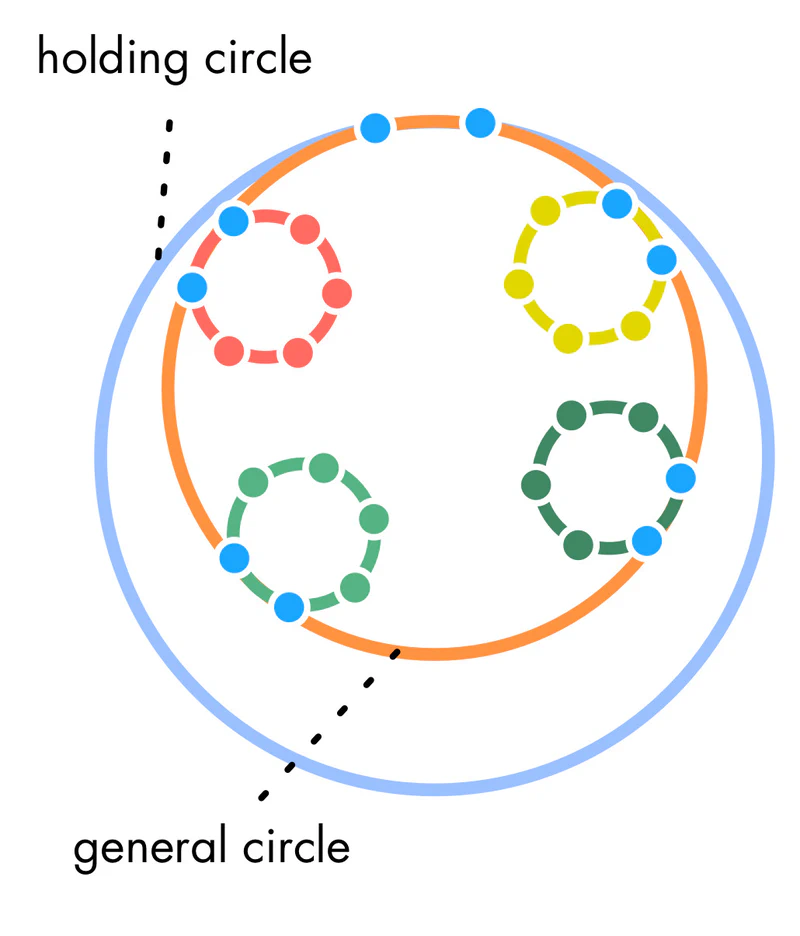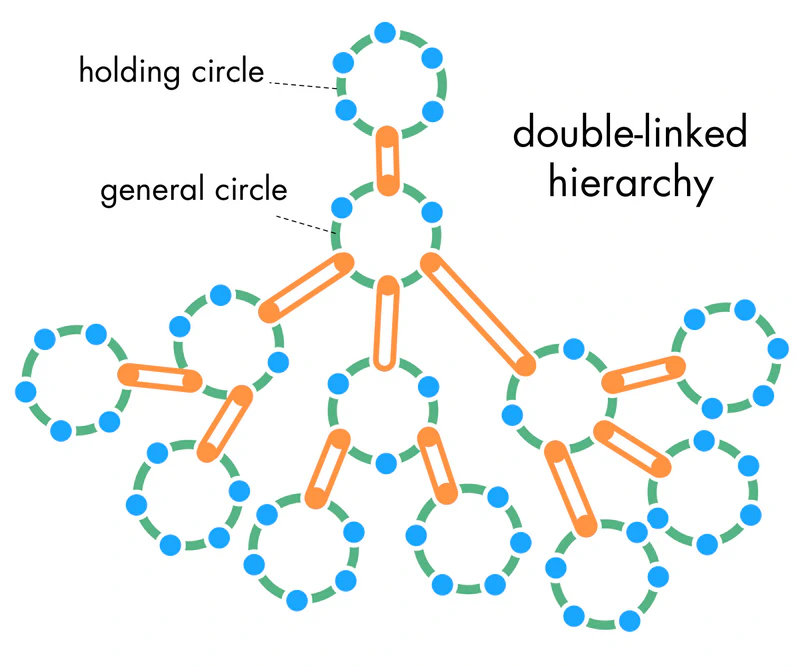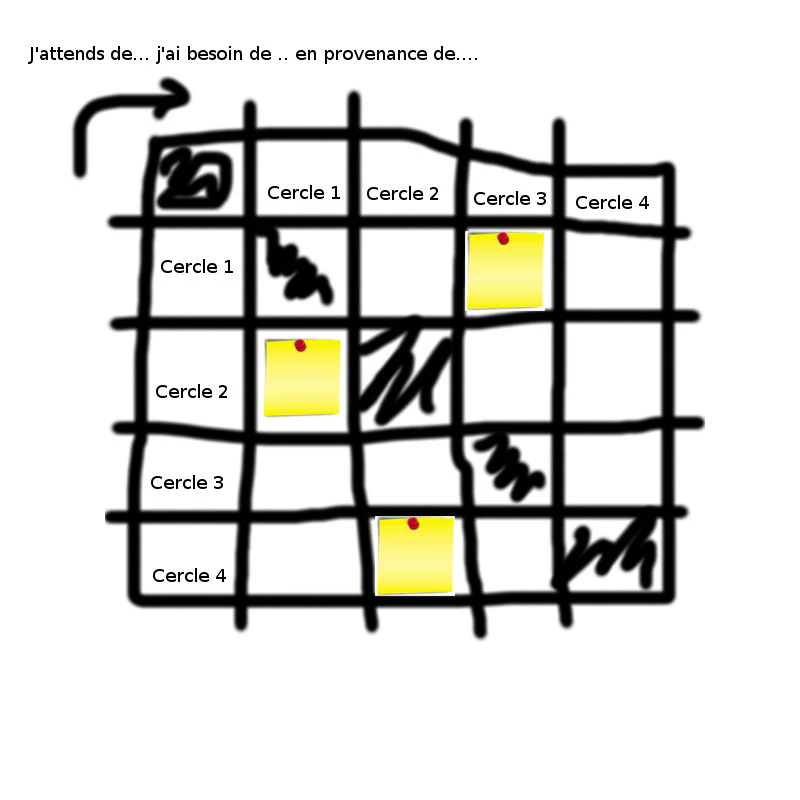This article aims to provide a brief perspective on holacracy, gothamocracy, sociocracy, or simply on a current approach that particularly appeals to me for supporting organizations.
I had already written that I thought rather well of this approach here (Hellocratie, Holocratie, Holacratie, Honolulucratie). It’s not new, but it synthesizes well, in my reading of it, the elements I believe in for the purpose of growing one’s organization. I think that in addition to my articles, those by Géraldine provide an operational dimension, so I recommend reading this coach’s blog. The objective of my article is to enable starting with holacracy, sociocracy, etc. while ensuring you’ve grasped a few fundamentals.
- Learn more about holacracy or sociocracy; Articles by Géraldine, my previous article: Hellocratie, Holocratie, Holacratie, Honolulucratie.
Continuous Evolution and Distribution of Power
These movements, notably sociocracy and even more so holacracy, could be reduced (without being diminished) to two key concepts:
- The importance of grasping that we are not in a transformation but in a constant evolution, a continuous evolution. The organization never stops moving; a system is needed that knows how to embrace this constant change.
- That all the value lies in implementing a distribution of power that involves autonomizing the created entities (circles, etc.). This is where the sought-after leverage is found.
If your implementation of these approaches doesn’t integrate these two components, I think it’s either vain because I believe in these two ideas (continuous evolution and distribution of power), or it’s not representative of what you could call holacracy or sociocracy. Thus as always, whatever name it bears matters little, it’s the underlying principles that are fundamental.
Framework and Authorization

It therefore seems key to me to understand the principle of encompassing circles and sub-circles regarding the delegation, the distribution of power. That an encompassed circle is a subset that attributes to itself a domain of competencies and intervention delegated by the superior circle. This is only possible if the framework is clarified. We clarify it by stating the purpose, the meaning, of the circle (the “driver” says sociocracy). We clarify it by defining its accountabilities (its duties) in relation to its purpose and in agreement with the circle that encompasses it, the one that delegated its authority to it. We clarify the framework by listing the domain, the intervention zones of this circle.
The circle and its participants feel authorized to take this space because the framework is clarified. The encompassing circle feels secure in delegating its authority because it will be regularly kept informed of the circle’s state through metrics (indicators) and checklists coming from it. As well as the guarantee that the purpose and accountabilities (duties) are being properly followed. There is an “ambassador” in a way, a function held by the lead link who personifies and embodies this delegation of power but who is above all a messenger of meaning because they will be part of this “sub” circle. Circles are not isolated, they are connected by these links.
Thus the principles of continuous evolution and distribution of power are made possible by the clarification of a framework and the delivery of an authorization de facto because constantly validated by respecting a purpose, accountabilities, the definition of an intervention domain and the constant flow of information: metrics and checklist, links.
The images are taken from sociocracy30.org which I particularly appreciate.
Two Types of Entities: Operational and by Affinity
What is sought through this distribution of power is autonomy. Because it’s autonomy that will allow an adequate response to today’s complex changing world. In this set of circles into which authorizations, power, are delegated, we quickly observe two families: operational circles and affinity circles.
In organizations, particularly in this agile world, we will have a vertical approach: multidisciplinary groups that can each propose a self-sufficient response, that are capable of delivering autonomous elements that make sense. In sociocracy and holacracy we therefore often have circles focused on an operational perimeter: I deliver what, why. But I am autonomous (therefore multidisciplinary) to deliver it. I call these operational circles.
On the other side we have circles that guarantee a transverse service to the organization: for example an HR circle, a software quality circle, etc. I call these affinity circles. Their role is to disseminate or to centralize, to capitalize. Their autonomy serves them to be able to decide on their perimeter, so they must be legitimate (example: the main HR representatives in an HR circle, but also perhaps experts from other fields to complete the points of view and have autonomy).
Communication Capacity

I don’t yet have enough perspective to tell you exactly the variations that these two types of entities will generate. But they exist without doubt, I perceive the effects in my missions. The first difficulty I observe is communication between these circles of different types: by delegating power into these groups, these circles, by protecting them, we have also potentially isolated them, especially between operational circles and affinity circles, not from the same “family”.
I told you that circles are not isolated but connected by links. Normally we therefore have power that is distributed with upward and downward flows of information: lead link, rep link, metrics, checklist. Holacracy like sociocracy are equipped for the upward and downward flow of information. It’s more the transverse information that has more difficulty circulating.
In my field observations, circles fulfill well their roles of these upward and downward flows of information. Transverse information is easily delivered through free communication, often oral, between circles. But sometimes the question is posed, and flat communication between circles is more problematic than it appears.

In this case I recently used an adaptation proposed by Dragos of a workshop called “give and take”. I create a simple matrix with all circles on the x-axis and y-axis (or all circles in a domain), and I use the intersection to express a need, an expectation. The question of the enclosure of inter-circle communication not encompassed/encompassing is systematically raised in my contexts. I sketch an example here.
This communication can also be resolved when people are part of multiple circles (in addition to people who are lead links and rep links). But be careful not to saturate people. Two circles seems reasonable per person.
Finally, these communication concerns that could appear are perhaps the sign of a lack of autonomy or clarity in the purpose, domain, accountabilities of the circle.
Emergence and Invitation
As very often in change management, we must privilege emergence and invitation.
We opt for the emergence of the adequate form and not plan the adequate form. It is therefore reasonable to start either by forming your circles according to your reality, what you are, then they will evolve as things progress since precisely this continuous evolution is at the heart of holacracy or sociocracy. (Thus emergence doesn’t stop either…) Or by creating first circles that make sense: in agreement with the meaning of the organization (which perhaps wasn’t to date organized accordingly). We can start by forming circles that represent reality, or you can start by creating a first multidisciplinary circle that establishes a new organization around meaning. For example: we need to address this market need: we create a first circle around it. It is often immediately depositary of a first encompassing circle carried by management. Things can change but reality and meaning is often that at the beginning.
To make emerge is therefore to follow a vision, a meaning, not a plan.
And in fact all conversations are possible because everyone knows this reality, this meaning, or discovers it or perceives better the gaps, the tensions, between the different visions. Emerging is quite simple: we ask for the primary meaning then we decline it according to needs into “sub”-encompassed circles.
Meaning, emergence, nothing should be forced. It remains an invitation.
Being prescriptive is slowing down appropriation, we should be able to invite people. We don’t take an organization where it doesn’t want to go, we don’t take people where they don’t want to go. I’m careful not to assign roles from the start too quickly: I let them emerge from tensions, needs, meaning. When the routine is established, roles can be processed more quickly (for example a new role appears that we deploy in all circles quickly). If we arrive with a ready-made role grid we will lock people into it. Roles like circles evolve as soon as it makes sense.
Organizational or Operational?
We often encounter Scrum and holacracy, we compare them, we mix them, but it’s a mistake. One responds to an operational need, the other wants to respond to the organization of the organization, to an organizational need. I suggest not mixing the levels of reading. Don’t start telling me: we need a scrummaster and a product owner in this circle, at least not from the outset. Holacracy and sociocracy propose circles to respond to the needs of the organization. A method like Scrum proposes roles that are endorsed with practices to accomplish things (in this case often products in a complex environment, and the complex is everywhere). It may therefore be that certain roles that emerge in circles are those of a method like Scrum, but if you link the two too strongly in your discourse you make reading the organization complicated, and you close doors to invitation and emergence.
Keep the right level of reading: that of the organization of the organization.
Don’t Follow to the Letter
Finally, naturally, and as always, don’t follow to the letter the frameworks, methods, etc. The principles must be followed, which is what I’ve tried to highlight here. The most flagrant deviations in my practice are:
- The emergence of roles over time (from tensions).
- Using the advice process instead of decision-making by consent.
- Those naturally proposed by Géraldine to integrate governance or strategy considerations into any triage meeting even if certain meetings are dedicated to these questions…
- …and not being rigid about too severe formalism in running meetings even if clarification and reaction must be healthily possible.
Should We Listen to Critics
Yes always.
Although they are often based on what I consider to be poor implementations of these principles that go beyond holacracy and sociocracy. A holacracy, a sociocracy, without emergence, without invitation, without distribution of power, without autonomy of circles can quickly transform into a rather inhuman crushing machine based solely on the dictate of rules without meaning.
One last word:
- Is there management? Naturally. Managers? much less.
- Is there a hierarchy? Naturally. But a hierarchy of meaning, more than of power. It’s not power that goes up and comes back down, but more the meaning.
See you soon.